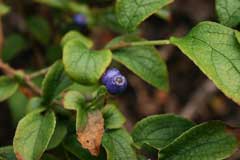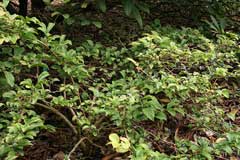 |
|
http://commons.wikimedia.org/wiki/User:Sten |
 |
| http://commons.wikimedia.org/wiki/User:Sten |
Translate this page:
Summary
Physical Characteristics

 Symplocos paniculata is a deciduous Shrub growing to 4 m (13ft) by 4 m (13ft).
Symplocos paniculata is a deciduous Shrub growing to 4 m (13ft) by 4 m (13ft).
See above for USDA hardiness. It is hardy to UK zone 5. It is in flower from May to June, and the seeds ripen from October to December. The species is hermaphrodite (has both male and female organs). The plant is not self-fertile.
Suitable for: light (sandy), medium (loamy) and heavy (clay) soils and prefers well-drained soil. Suitable pH: mildly acid soils and can grow in very acid soils.
It cannot grow in the shade. It prefers moist soil.
UK Hardiness Map
US Hardiness Map
Synonyms
S. chinensis. (Lour.)Druce. Prunus paniculata. Thunb.
Plant Habitats
Woodland Garden Sunny Edge; Dappled Shade;
Edible Uses
Edible Parts: Fruit
Edible Uses:
Fruit - cooked[177]. Used in jams, jellies and sauce[183]. The fruit is about 8mm in diameter[200].
References More on Edible Uses
Medicinal Uses
Plants For A Future can not take any responsibility for any adverse effects from the use of plants. Always seek advice from a professional before using a plant medicinally.
Astringent Ophthalmic Tonic
The bark is astringent, cooling and tonic[240]. It is useful in the treatment of menorrhagia, bowel complaints, eye diseases and ulcers[240]. It is also used as a gargle for giving firmness to spongy and bleeding gums[240]. The juice of the bark is applied externally to sprains and muscular swellings[272].
References More on Medicinal Uses
The Bookshop: Edible Plant Books
Our Latest books on Perennial Plants For Food Forests and Permaculture Gardens in paperback or digital formats.

Edible Tropical Plants
Food Forest Plants for Hotter Conditions: 250+ Plants For Tropical Food Forests & Permaculture Gardens.
More

Edible Temperate Plants
Plants for Your Food Forest: 500 Plants for Temperate Food Forests & Permaculture Gardens.
More

More Books
PFAF have eight books available in paperback and digital formats. Browse the shop for more information.
Shop Now
Other Uses
Dye Mordant Wood
A yellow or red dye is obtained from the leaves and bark[51, 146, 158, 272]. We have no specific information for this species but many species in this genus contain alum and can be used as mordants when dyeing[168]. Wood - white, soft to moderately hard. close grained, liable to twist and split when seasoning. Of possible use in turnery[146, 158].
Special Uses
Scented Plants
References More on Other Uses
Cultivation details
Requires an acid soil and a sunny position. Succeeds in a sunny position in any well-drained fertile neutral to acid soil[182, 200]. One report says that plants are hardy to about -10°c, though it is also said that they can survive quite harsh winters outdoors in Britain but that they need a warm, sunny protected position and a hot summer if they are to fruit well[11, 200]. The fruits are sometimes spoiled by frosts[200]. The flowers are sweetly fragrant[200, 245]. Self-sterile, it needs cross-pollination with a different plant in the same species if seed and fruit are to be produced[11, 182]. Plants in this genus are notably resistant to honey fungus[200].
References Carbon Farming Information and Carbon Sequestration Information
Temperature Converter
Type a value in the Celsius field to convert the value to Fahrenheit:
Fahrenheit:
The PFAF Bookshop
Plants For A Future have a number of books available in paperback and digital form. Book titles include Edible Plants, Edible Perennials, Edible Trees,Edible Shrubs, Woodland Gardening, and Temperate Food Forest Plants. Our new book is Food Forest Plants For Hotter Conditions (Tropical and Sub-Tropical).
Shop Now
Plant Propagation
Seed - best sown in a cold frame as soon as it is ripe. Stored seed requires stratification and is best sown in a cold frame in late winter, it can take 12 months to germinate[11]. Prick out the seedlings into individual pots when they are large enough to handle and grow them on in the cold frame for their first winter. Plant out in late spring or early summer. Cuttings of half-ripe wood, 7 - 10cm with a heel, July/August in individual pots in a cold frame[78, 200]. Roots are formed in about 4 weeks. Good percentage[78].
Other Names
If available other names are mentioned here
Native Range
TEMPERATE ASIA: China (Anhui Sheng, Fujian Sheng, Guangdong Sheng, Guangxi Zhuangzu Zizhiqu, Guizhou Sheng, Hainan Sheng, Hebei Sheng, Heilongjiang Sheng, Henan Sheng, Hubei Sheng, Hunan Sheng, Jiangsu Sheng, Jiangxi Sheng, Jilin Sheng, Liaoning Sheng, Nei Mongol Zizhiqu, Ningxia Huizi Zizhiqu, Shaanxi Sheng, Shandong Sheng, Shanxi Sheng, Sichuan Sheng, Xizang Zizhiqu, Yunnan Sheng, Zhejiang Sheng), Korea, Japan (Hokkaidô, Honshu, Kyushu, Shikoku), Taiwan TROPICAL ASIA: Bangladesh, Bhutan, India (Arunachal Pradesh, Himachal Pradesh, Jammu and Kashmir, Meghalaya, Nagaland, Punjab, Uttar Pradesh, Manipur, Sikkim), Laos, Myanmar (north), Vietnam
Weed Potential
Right plant wrong place. We are currently updating this section.
Please note that a plant may be invasive in one area but may not in your area so it's worth checking.
Conservation Status
IUCN Red List of Threatened Plants Status :

Growth: S = slow M = medium F = fast. Soil: L = light (sandy) M = medium H = heavy (clay). pH: A = acid N = neutral B = basic (alkaline). Shade: F = full shade S = semi-shade N = no shade. Moisture: D = dry M = Moist We = wet Wa = water.
Now available:
Food Forest Plants for Mediterranean Conditions
350+ Perennial Plants For Mediterranean and Drier Food Forests and Permaculture Gardens.
[Paperback and eBook]
This is the third in Plants For A Future's series of plant guides for food forests tailored to
specific climate zones. Following volumes on temperate and tropical ecosystems, this book focuses
on species suited to Mediterranean conditions—regions with hot, dry summers and cool, wet winters,
often facing the added challenge of climate change.
Read More
Expert comment
Author
(Thunb.)Miq.
Botanical References
11200266
Links / References
For a list of references used on this page please go here
Readers comment
| Add a comment |
|
If you have important information about this plant that may help other users please add a comment or link below. Only comments or links that are felt to be directly relevant to a plant will be included. If you think a comment/link or information contained on this page is inaccurate or misleading we would welcome your feedback at [email protected]. If you have questions about a plant please use the Forum on this website as we do not have the resources to answer questions ourselves.
* Please note: the comments by website users are not necessarily those held by PFAF and may give misleading or inaccurate information.
To leave a comment please Register or login here All comments need to be approved so will not appear immediately.
|
Subject : Symplocos paniculata
|
|
|
|